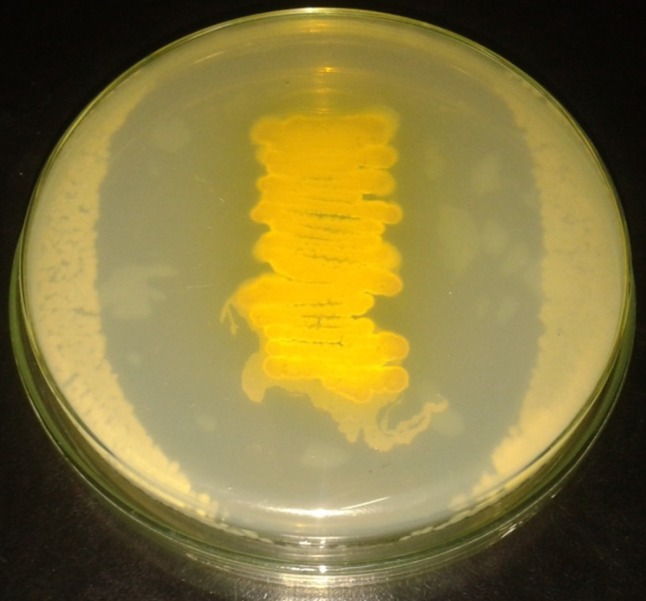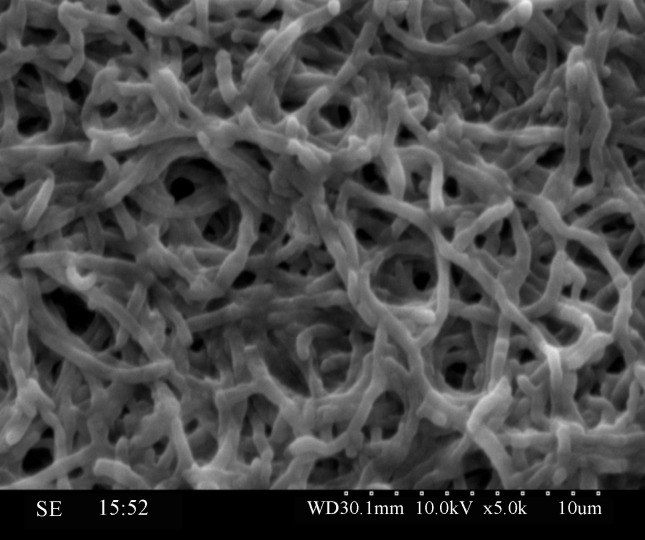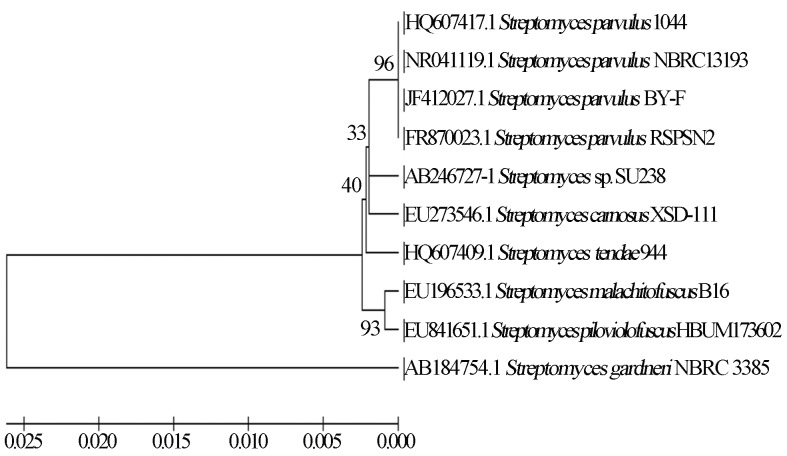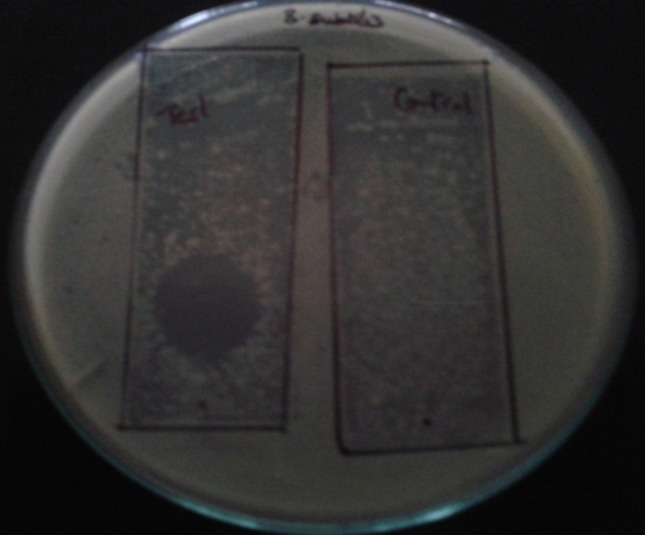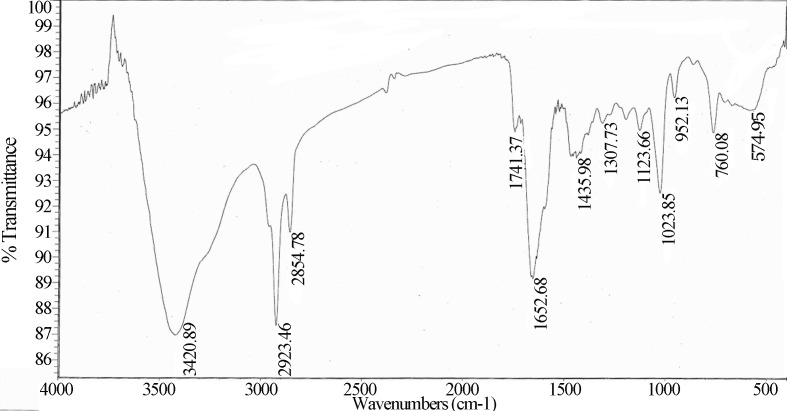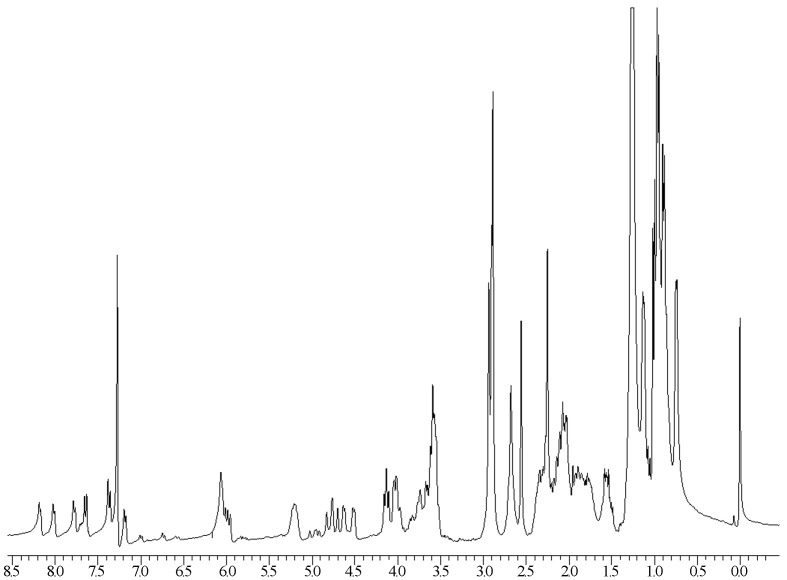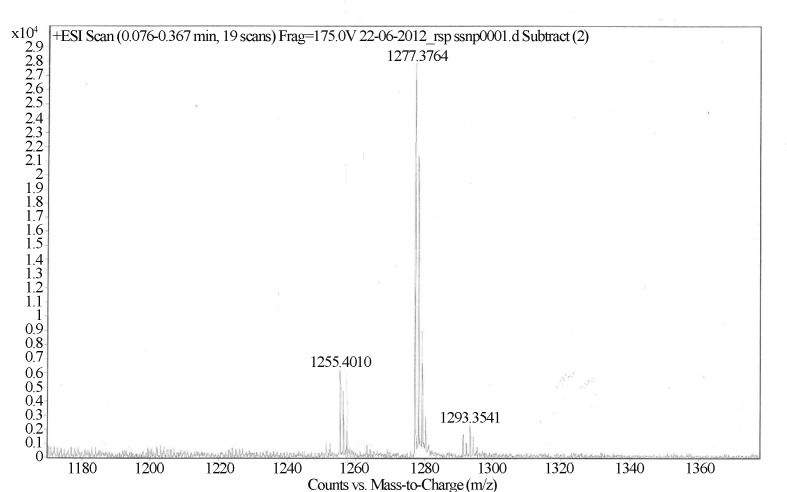Abstract
A highly potent secondary metabolite producing actinomycetes strain is isolated from marine soil sediments of Visakhapatnam sea coast, Bay of Bengal. Over all ten strains are isolated from the collected soil sediments. Among the ten actinomycetes strains the broad spectrum strain RSPSN2 was selected for molecular characterization, antibiotic production and its purification. The nucleotide sequence of the 1 rRNA gene (1261 base pairs) of the most potent strain evidenced a 96% similarity with Streptomyces parvulus 1044 strain, Streptomyces parvulus NBRC 13193 and Streptomyces parvulus BY-F. From the taxonomic features, the actinomycetes isolate RSPSN2 matches with Streptomyces parvulus in the morphological, physiological and biochemical characters. Thus, it was given the suggested name Streptomyces parvulus RSPSN2. The active metabolite was extracted using ethyl acetate (1:3, v/v) at pH 7.0. The separation of active ingredient and its purification was performed by using both thin layer chromatography (TLC) and column chromatography (CC) techniques. Spectrometric studies such as UV-visible, FTIR, and NMR and mass were performed. The antibacterial activity of pure compound was performed by cup plate method against some pathogenic bacteria including of streptomycin resistant bacteria like (Pseudomonas mirabilis, Pseudomonas putida and Bacillus cereus). In conclusion, the collected data emphasized the fact that a polypeptide antibiotic (Actinomycin D) was produced by Streptomyces parvulus RSPSN2.
Keywords: polypeptide antibiotic, Streptomyces parvulus, 1 rRNA characterization, antibacterial activity, Streptomycin resistance
Introduction
Antimicrobial resistance is not new, but the number of resistant organisms, the geographic locations affected by drug resistance, and the breadth of resistance in single organisms are unprecedented and mounting (Levy, 2002). Diseases and disease agents that were once thought to be controlled by antibiotics are returning in new leagues resistant to these therapies. Several mechanisms have evolved in bacteria which confer them with antibiotic resistance. These mechanisms can chemically modify the antibiotic, render it inactive through physical removal from the cell, or modify target site so that it is not recognized by the antibiotic. Antibiotic resistance in bacteria may be an inherent trait of the organism (e.g. a particular type of cell wall structure) that renders it naturally resistant, or it may be acquired by means of mutation in its own DNA or acquisition of resistance-conferring DNA from another source.
Marine microorganisms continue to provide pharmacologically important secondary metabolites which are unique and novel chemical compounds. They are continuously explored for drug discovery. Microbes like bacteria, fungi, actinomycetes can sense, adapt and respond to their environment quickly and can compete for defense and survival by the generation of unique secondary metabolites. These compounds are produced in response to stress and many have shown value in biotechnological or pharmaceutical applications.
Marine environment is the rich source of actinomycetes and bacteria. Among them actinomycetes are the most economically and biotechnologically important prokaryotes; hold a prominent position due to their diversity and proven ability to produce novel bioactive compounds. About 70% of the world’s naturally occurring antibiotics are produced by actinomycetes (Okami et al., 1988). Antibiotics produced by actinomycetes are still in infant stage. Out of 1025–1026 in 1 m of global soil only 105 have been screened for antibiotics production in the past 50 years. There is plenty of space is left to be screened further (Baltz 2007). The biodiversity of actinomycetes is an important factor for screening of novel antibiotics. Marine sources like soil sediments, coral reefs, sponges are rich sources of actinomycetes which produces highly potential novel bioactive compounds. Actinomycetes are known to produce various types of antibiotics namely peptide/glycopeptides, angucyclinone, tetracyclines, phenazine, macrolide, anthraquinone, polyene, nonpolyene, benzoxazolophenanthridine, heptadecaglycoside, lactones and others.
In the present study, we report the findings of antimicrobial property of a polypeptide secondary metabolite (Actinomycin D) which is active against streptomycin resistant bacteria (Pseudomonas putida and Bacillus cereus) produced by marine actinomycetes screened from soil sediments collected from the coast of Bay of Bengal.
Materials and Methods
Sample collection
Marine soil sediment samples were collected from Visakhapatnam coast from deeper regions of Bay of Bengal. The collected sample was stored into a sterile glass screw cap bottle and sealed tightly. This collected sediment sample was kept for screening and isolation of different actinomycetes strains.
Screening and isolation of actinomycetes
Few grams of soil sediment were taken and it was added to 50 mL of sterile distilled water in a 250 mL Erlenmeyer flask. The flask was kept for shaking on an orbital shaker for 30 min at 27 °C and performed serial dilutions from 10−1 to 10−9. From each dilution about 1 mL of sample is taken and it was placed on starch casein agar medium along with antibiotics, Cycloheximide (5 g/mL) and Rifampicin (g/mL) by pour plate technique and incubated at 27 °C for 2 to 3 weeks. After incubation period is completed the actinomycetes colonies were carefully picked by avoiding bacterial and fungal contamination and the picked colonies were sub-cultured on to YEME (Yeast extract and Malt extract) agar slants. The slants were maintained at room temperature.
Preliminary screening for antibiotics
The isolates were initially screened for antimicrobial activity by agar overlay method. In agar overlay method firstly the actinomycetes isolates were stabbed on YEME (Yeast extract and Malt extract) agar plates. The plates were incubated for 72 to 96 h at 27 °C. After suitable growth is obtained the plates were plated with test organism such as Bacillus subtilis on the surface of actinomycetes isolates with less percentage of agar (0.5%). The plates were then incubated at 37 °C for 18 to 24 h. The isolates which show activity against test organism were collected. Among the collected isolates the potential isolate is selected for further studies.
Identification of organism
Growth and morphology of the selected potential strain (RSPSN2) was observed on ISP-M4 (Inorganic salts & starch agar), ISP-M6 (Peptone – yeast extract – iron agar), milk agar, starch – casein agar and oatmeal agar. For the micro-morphology and external morphology of the strain scanning electron microscopy (SEM analysis) were performed by using Hitachi- S520, Japan; Oxford Link ISIS-300 UK scanning electron microscope. The biochemical characterization of the isolated strain (RSPSN2) many tests were performed such as temperature tolerance, pH tolerance and NaCl concentration (minimum, optimum and maximum). Specific tests like Gram staining, spore staining, motility, indole production, MR-VP test, gelatin hydrolysis, citrate utilization, triple sugar iron agar, oxidase test, catalase production, nitrate reduction, urease test and starch hydrolysis. Fermentation of different sugars as sole carbon sources such as arabinose, sucrose, glucose, fructose, rhamnose, xylose, raffinose and mannitol etc. Analysis of the 16S rRNA begins by isolating DNA and amplifying the gene coding for 16S rRNA using the polymerase chain reaction. The purified DNA fragments are directly sequenced. The sequencing reactions are performed using DNA sequencer in order to determine the order in which the bases are arranged with in the length of the sample and a computer is used for studying the sequence for identification using Phylogenetic analysis procedures. Molecular based characterization based on ribotyping of 16S rRNA was performed at Microbial Type Culture Collection centre, IMTECH, Chandigarh.
Phylogenetic analysis
Nucleotide sequences were compared with those maintained in the GenBank Database through NCBI Blast (http://www.ncbi.nlm.nih.gov). Alignment of nucleotide sequences was done using a cluster method of the DNASTAR software program (DNASTAR Inc., Madison, WI, USA). Data analysis was performed on a bootstrapped dataset containing 1000 replicates. In order to determine the genetic relationship between these strains, a Phylogenetic tree was generated based on the percentage difference between the sequences using the neighbor-joining method in the MEGA 5.05 software.
Fermentation
The preserved slants are used as inoculums for the preparation of seed medium. The seed medium is composed of yeast extract 0.5%, dextrose 1.0%, starch 2.0%, casein enzyme hydrolysate 0.5%, ammonium sulphate 0.5% and calcium carbonate 0.4%. 50 mL of seed medium is prepared in 250 mL Erlenmeyer flask and it was inoculated with isolate RSPSN2 incubated for 48 h at 27 °C at 150 rpm. Five mL of the inoculum from seed medium after incubation was aseptically transferred to 95 mL of production media composed of yeast extract 0.5%, dextrose 1.0%, starch 2.0%, casein enzyme hydrolysate 0.5%, ammonium sulphate 0.5%, calcium carbonate 0.4% and water (80% marine water) kept on rotary shaker (150 rpm) at 30 °C for 14 days. Various seed media and production media were tested and finally the best medium was selected in order to get maximum yield of the final desired product. Improvement of antibiotic yield was also monitored from 7th day to 14th day by performing cup plate method.
Extraction and isolation of active compound
After fermentation, the medium was centrifuged at 10,000 rpm for 10 min at 4 °C to remove the biomass and cell debris. As the antibiotic produced is extracellular, the supernatant was collected and checked for antimicrobial activity. Solvent extraction was done to isolate active substances from cultured supernatant. Ethyl acetate was seen to be compatible for extraction of antibiotics. The culture filtrate was therefore extracted with ethyl acetate in the ratio of 3:1. The mixture (media and solvent) was shaken vigorously for 15 min and kept stationary for another 15 min to separate the organic phase from the aqueous phase. The organic phase was collected and concentrated in rotary vacuum evaporator. The crude extract was then dried in desiccators for few days. The dried crude extract was then tested for antimicrobial activity against selected test organisms by performing bio-autography. In this technique simultaneously we can separate the crude extract into individual components and detect which individual component is exhibiting antimicrobial activity.
TLC of crude extract and bio-autography
Separation of antibacterial compound from the crude extract is done by thin layer chromatography. The mobile phase used is dichloromethane-ethyl acetate (20:80). After ascending the plate was taken out and dried, sprayed with anisole reagent to detect the spots. After separating the spots the active spot is confirmed by bio-autography studies. The crude extract was kept for bio-autography studies. Here we followed contact bio-autography against bacterial test organisms. Initially the crude extract was loaded onto pre-coated TLC plates with the capillary tubes and eluted using different mobile solvent systems and the best one was fixed based upon the separation (Rf value) (dichloromethane-ethyl acetate (20:80)). The developed plates were dried under a stream of fast moving air for an hour to remove traces of solvent on the plates. Bacteria (E. coli, B. subtilis), suspension of 24 h cultures grown on nutrient agar slants were freshly prepared in sterile distilled water.
Now plating was done using inoculated nutrient agar with the prepared bacterial suspensions by spread plate technique. The dried TLC plates were placed onto the media with the help of sterilized forceps. These plates were kept in refrigerator for one hour for diffusion. Now markings should be done, later TLC plates were removed. This whole process was carried out aseptically in a Laminar flow cabinet. Thereafter, these plates were incubated overnight at 37 °C. A control was also kept using solvent alone. The inhibition zone diameters should be observed for which spot is active.
Purification by column chromatography
Column chromatography was carried out for the separation of active compound of RSPSN2 crude extract from production. The crude extract is adsorbed on to stationary phase of 100: 200 silica gel mesh size. Mobile phase was dichloromethane-ethyl acetate (20:80). The eluent is passed through the column by gravity. 10 mL each fraction was collected and checked with TLC for purity. The fractions with same spots were mixed and the solvent was evaporated on rotary evaporator. The pure fraction is studied for further analysis.
Bio-autography of pure fraction
Contact bio-autography was followed. Initially the pure fractions were loaded onto pre-coated TLC plates and eluted using dichloromethane-ethyl acetate (20:80). The developed plates were dried to remove traces of solvent on the plates. Bacterial (E. coli, B. subtilis), suspensions of 24 h cultures were freshly prepared in sterile distilled water. Now plating was done using inoculated nutrient agar with the prepared bacterial suspensions by spread plate technique. The dried TLC plates were placed onto the media with the help of sterilized forceps. These plates were kept in refrigerator for one hour for diffusion. Now markings should be done, later TLC plates were removed. This whole process was carried out aseptically in a Laminar flow cabinet. Thereafter, these plates were incubated overnight at 37 °C. A control was also kept using solvent alone.
Spectroscopy of the compound
The ultra violet and visible spectra of the active compound were recorded using spectroscopic grade ethyl acetate in UV-visible spectrophotometer (XP – 2001, EXPLORER). Infra red (IR) spectrum of the active compound was investigated in KBr with Perkin-Elmer-IR-683 spectrophotometer, and NMR spectra were recorded at 30 Hz in CDCl3 with Bruker-Avanxce-300 instrument. Mass spectrum was recorded by using AUTOSPEC-M, Micromass, UK.
Antibacterial activity
Antibacterial activity of the active compound is studied by cup plate method. Totally fourteen strains were used for the activity which includes Gram positive and Gram nagative (Bacillus subtilis, Bacillus megatherium, Bacillus cereus, Bacillus sphereus, Bacillus sterothermophilus, Micrococcus luteus, Proteus vulgaris, Klebsiella pnuemoniae, Escherichia coli, Pseudomonas putida, Salmonella typhi, Salmonella paratyphi, Proteus mirabilis, Pseudomonas aeruginosa). Among the fourteen strains two strains (Pseudomonas putida and Bacillus cereus) are resistant to streptomycin (Aminoglycoside antibiotic). All the test strains are prepared freshly (i.e., 24 h cultures) for activity studies. Nutrient agar medium is prepared, autoclaved and plated in a sterile Petri plates after solidification test strains are inoculated by spread plate technique. Wells are made by sterile cork borer totally three wells are made in each plate one is for test sample, one is for standard (streptomycin) and last one is for control (ethyl acetate). 50 μL (100 μg/mL conc.) of test sample is poured in each well and the same amount of standard (streptomycin 100 μg/mL conc.) and control is also poured in their respective wells. The plates are incubated at 37 °C for 18 to 24 h then the zone of inhibition diameters were measured by using calibrated scale.
Results
Screening and isolation of actinomycetes
In the course of screening for novel antimicrobial substances (antibiotics) from marine soil sediment samples collected from Bay of Bengal of Visakhapatnam coast, several actinomycetes colonies were screened and isolated. Actinomycetes have provided many important bioactive compounds of high commercial value and continue to be routinely screened for new bioactive substances.
In the present study about 10 actinomycetes were isolated using starch casein agar medium (Williams et al., 1965). The isolated cultures were sub-cultured on YEME (yeast extract and malt extract) agar slants and preserved in refrigerator. Further screening was done to determine the bioactivity of the isolates.
Screening for secondary metabolites
The isolated actinomycetes strains were further screened for secondary metabolites (antibiotic production) by agar overlay method (Harborne 1973, 1989). Most of the strains show antibacterial activity out of this one strain RSPSN2 shows potential antibacterial activity against both Gram positive and Gram negative bacteria. (Figure 1) Shows the potential antibacterial activity of RSPSN2 against Bacillus subtilis which is selected for further studies.
Figure 1.
Agar overlay method for determining the antibacterial potential of secondary metabolite produced by Streptomyces parvulus RSPSN2.
Identification of microorganism
The aerial mycelium is greyish colour in YEME medium and the substrate mycelium is whitish colour. A diffusible yellow coloured pigment is produced in to YEME agar medium. Spores are smooth and spherical. The organism grows as convex colonies with tufted powdery mass. (Figure 2) shows the scanning electron micrograph (SEM) picture of aerial mycelium of RSPSN2 strain (Houssam et al., 2009). Growth characteristics of RSPSN2 strain in different media were summarized in (Table 1). The vegetative mycelia grow abundantly in both complex and simple media. The aerial mycelia grow abundantly on tryptone yeast extract broth (ISP-1), yeast extract and malt extract broth (ISP-2), growth is moderate in glycerol asparagine broth (ISP-5) and tyrosine agar medium (ISP-7) and the growth is poor in inorganic starch agar (ISP-4) medium (Sivakumar et al., 2007). The cell wall hydrolysate contains LL-DAP as main amino acid (Lechevalier et al., 1968) and sugars are not detectable. The physiological and biochemical characteristics of actinomycetes isolate RSPSN2 were summarized in (Table 2 and Table 3) according to Pridham et al., 1948, Pridham et al., 1957; Chapman 1952; Cowan 1974.
Figure 2.
Scanning electron micrograph (SEM) of aerial mycelium of Streptomyces parvulus RSPSN2.
Table 1.
Culture characteristics of Streptomyces parvulus RSPSN2 on different culture media.
| Media | Growth | Aerial mass colour | Pigmentation |
|---|---|---|---|
| Tryptone Yeast extract agar (ISP 1) | Moderate | White | - |
| Yeast extract malt extract agar (ISP 2) | Good | Grey | Yellow |
| Oat meal agar (ISP 3) | Poor | White | - |
| Inorganic salt agar (ISP 4) | Poor | White | - |
| Glycerol – Aspargine agar (ISP 5) | Moderate | White | - |
| Tyrosine agar (ISP 7) | Good | Grey | - |
Table 2.
Physiological growth characteristics of Streptomyces parvulus RSPSN2.
| Sl.no | Temperature (°C) | Growth |
|---|---|---|
| 1 | 15 | − |
| 2 | 25 | + |
| 3 | 37 | + |
| 4 | 42 | + |
| pH | Growth | |
| 1 | 5 | − |
| 2 | 8 | + |
| 3 | 9 | + |
| 4 | 10 | + |
| % NaCl | Growth | |
| 1 | 2 | + |
| 2 | 5 | + |
| 3 | 7 | − |
| 4 | 10 | − |
Table 3.
Biochemical characteristics of Streptomyces parvulus RSPSN2.
| Sl.no | Test | Result |
|---|---|---|
| 1 | Gram staining | + |
| 2 | Spore staining | + |
| 3 | Motility | − |
| 4 | Starch hydrolysis | + |
| 5 | Casein hydrolysis | − |
| 6 | Citrate utilization | + |
| 7 | Gelatin liquefaction | − |
| 8 | H production | − |
| 9 | Melanin reaction | − |
| 10 | Nitrate reduction | + |
| 11 | Indole production | + |
| 12 | Catalase | + |
| 13 | Urease | + |
| 14 | Oxidase | + |
| 15 | Voges proskuear | − |
| 16 | Diaminopimelic acid (DAP) | + |
| 17 | Sugar pattern | No detectable sugars |
| 18 | Acid production with different sugars | |
| Arabinose | − | |
| Ribose | + | |
| Rhamnose | − | |
| Mannitol | − | |
| Dextrose | + | |
| Fructose | + | |
| Sucrose | − | |
| Galactose | − | |
| Mannose | − | |
| Inositol | − | |
| Salicin | + | |
| Raffinose | − |
16S rRNA ribotyping and Phylogenetic analysis of RSPSN2 strain
The 16S rRNA gene sequencing analysis of the isolate yielded 1261 base pairs and NCBI BLAST search analysis showed that the sequence was 96% similar to the sequence of Streptomyces parvulus 1044 strain, Streptomyces parvulus NBRC 13193 and Streptomyces parvulus BY-F. The observed distinct Phylogenetic position also further confirmed the constructed Phylogenetic tree based on Maximum-parsimony method (Figure 3) (Prakasham et al., 2012). Hence, this isolate is designated as Streptomyces parvulus RSPSN2.
Figure 3.
Relationships between Streptomyces parvulus RSPSN2 (FR870023) and members of the genus Streptomyces on rooted Maximum-parsimony tree based on 1 rRNA sequences.
Production of antibiotic
Initially the production of antibiotic was carried out in three different media (PM-2: yeast extract 0.5%, dextrose 1.0%, starch 2.0%, casein hydrolysate 0.5%, ammonium sulphate 0.5%, calcium carbonate 0.4%) (PM-5: glycerol 2.0%, peptone 0.5%, yeast extract 0.3%, malt extract 0.3%, calcium carbonate 0.25%) (PM-7: glucose 1.0%, starch 1.0%, peptone 0.75%, meat extract 0.75%, sodium chloride 0.3%)) with 80% sea water (Suthindhiran et al., 2009) to check for maximum production of antibiotic. Among the three media PM-2 shows maximum production of antibiotic. Initially seed medium is prepared and it is inoculated with RSPSN2 strain and kept incubation for 48 h at 30 °C at 150 rpm then 5 mL of seed medium is transferred to production medium (PM-2) which was kept incubated for about two weeks at 30 °C, 150 rpm. From 7th day onwards supernatant is collected and checked for antibacterial activity. 10th day shows maximum zone of inhibition which confirms the maximum production is on 10th day, later on there is no significant increase in the production of antibiotic on further incubation.
Extraction of antibiotic
After incubation time is completed cell mass is removed by centrifugation at 10,000 rpm for 15 min supernatant is collected and cell mass pellet is discarded. One volume of ethyl acetate is added to the three volumes of culture supernatant to extract the antibiotic compound. Ethyl acetate layer is separated from the aqueous layer by using separating funnel and the ethyl acetate layer is concentrated at 50 °C by using rota evaporator to get the crude extract.
TLC of crude extract and Bio-autography
Separation of active compound from the crude extract is done by thin layer chromatography. The crude extract was dissolved in small amount of ethyl acetate for performing TLC. Initially different solvent systems were tried to separate the compounds finally the best suited one is selected i.e., dichloromethane: ethyl acetate (20:80). After ascending the plate was taken out and dried, then sprayed with anisole reagent. Totally four spots were detected out of which one is UV active with Rf 0.2 (Sahin et al., 2003). The active spot is confirmed by bio-autography. Based up on the preliminary antibacterial screening results, contact bio-autography is employed to detect if a single compound or multiple compounds is responsible for antibacterial activity. It is an analytical technique in which organic compounds are separated by chromatography and identified by studying their effects on microorganisms. Bio-autography is a laboratory technique to detect substances affecting the growth rates of test organisms in complex mixtures. The method is based on the biological activity of the analyte, which can be antibacterial, antifungal, etc. The result of bio-autography revealed that out of four spots detected on TLC plate only one spot with Rf 0.2 (which is UV active) shows the antibacterial activity. The zone of inhibition at 0.2 Rf is shown in the (Figure 4).
Figure 4.
Bio-autography of the crude extract of antibiotic produced by the Streptomyces parvulus RSPSN2.
Purification by column chromatography
By the bioautography test, we confirmed the active metabolite. The ethyl acetate extract of RSPSN2 organism was chromatographed on Sephadex LH-20 using 1:1 dichloromethane-methanol as eluent, to afford compound, which was purified by silica gel (# 100–200) using 1:4 dichloromethane-ethyl acetate as eluent.
Spectroscopic analysis of the compound
The purification process through column chromatography packed in silica gel eluted with dichloromethane and ethyl acetate 20:80 (v/v) resulted in the pure compound. The absorption spectrum of pure compound was determined in the UV-visible region (200–800 nm) by using spectrophotometer. The FTIR spectrum of pure compound was detected.
The ultraviolet absorption spectrum was recorded a maximum absorption peak at 242 m (Dhanasekaran et al., 2008). The compound in its IR spectrum exhibits a bands at 3421, 2924, 2855, 1741, 1653, 1436, 1124, 1024, 952, 760 cm−1 (Dhanasekaran et al., 2008) from which the presence of a primary amine, hydroxyls, alkenes, a primary amide and carbonyls groups are inferred (Figure 5). The 1H-NMR spectrum (Figure 6) of the compound exhibits signals at δ 0.74 (d, 6 H, J = 4. z), 0.89 (d, 2 H, J = z), 0.92–1.03 (m, 6 H), 1.13 (d, 5 H, J = z), 1.18–1.31 (br. s, 27 H), 1.52–1.60 (dd, J = 5.3, z), 1.99–2.09 (dd,, J = 3.8, 9. z), 2.21–2.27 (br. s, 3 H), 2.48–2.59 (br. s, 3 H), 2.68 (s, 4 H), 2.89 (d, 5 H, J = 4. z), 2.93 (s, 1 H), 3.5–3.64 (m, 6 H), 3.98–4.07 (dd, 2 H, J = 2.3, z), 4.13 (t, 1 H, J = 8.3, 15. z), 4.47–4.66 (dd, 2 H, J = 5.2, 3 z), 4.76 (t, 1 H, J = 19.6, 38. z), 5.11–5.29 (dd, 2 H, J = 6, 9. z), 5.92–6.16 (m, 4 H), 7.18 (d, 1 H, J = 6. z), 7.36 (d, 1 H, J = 7. z), 7.64 (d, 1 H, J = 7. z), 7.77 (d, 1 H, J = z), 8.02 (d, 1 H, J = 5. z), 8.17 (d, 1 H, J = 4. z).
Figure 5.
FT-IR Spectrum of active metabolite isolated from Streptomyces parvulus RSPSN2.
Figure 6.
NMR spectrum of the antibacterial agent produced by the Streptomyces parvulus RSPSN2.
The mass spectrum recorded by using AUTOSPEC-M, Micromass, UK showed the molecular weight of the compound as 1255.40 g/mole (M+ peak), 1277.3764 (M + Na+), 1293.3541 (M + K+) (Figure 7) which is exactly similar to Actinomycin D (Ajijur et al., 2010).
Figure 7.

Mass Spectrum of antibacterial agent produced by the Streptomyces parvulus RSPSN2.
Antibacterial activity
The compound exhibits a potent antibacterial activity against a wide range of both Gram negative and Gram positive bacteria (Table 4). The zones of inhibitions of this compound were compared with the zone of inhibitions of streptomycin (Usha et al., 2010). The zone of inhibitions (Figure 8) of the compound was almost identical with the streptomycin (Ajijur et al., 2010; Prakasham et al., 2012). More over the pathogenic bacterial strains (Bacillus cereus, Pseudomonas putida) which are resistant to streptomycin are inhibited by the isolated compound which shows that the isolated compound is more potent than the standard drug (Figure 8). The compound exhibits activity against both Gram positive and Gram negative bacteria which infers that the isolated compound is a broad spectrum antibiotic.
Table 4.
Antibacterial activity of secondary metabolite produced by Streptomyces parvulus RSPSN2 against different bacterial pathogens.
| Sl.no | Test organism | Diameter of zone of inhibition (mm) | ||
|---|---|---|---|---|
|
|
||||
| Standard (streptomycin) | Test (RSPSN2) | Control (Ethyl acetate) | ||
| 1 | Bacillus megaterium | 19 | 16 | 00 |
| 2 | Bacillus cereus | 00 | 27 | 00 |
| 3 | Bacillus sphaericus | 26 | 24 | 00 |
| 4 | Bacillus stearothermophilus | 21 | 25 | 00 |
| 5 | Pseudomonas aeruginosa | 25 | 25 | 00 |
| 6 | Pseudomonas putida | 00 | 30 | 00 |
| 7 | Proteus mirabilis | 26 | 22 | 00 |
| 8 | Micrococcus luteus | 23 | 27 | 00 |
| 9 | Bacillus subtilis | 27 | 29 | 00 |
| 10 | Salmonella typhi | 26 | 23 | 00 |
| 11 | Salmonella paratyphi | 20 | 25 | 00 |
| 12 | Escherichia coli | 27 | 40 | 00 |
| 13 | Klebsiella pneumoniae | 21 | 28 | 00 |
Figure 8.
Antibacterial activity of the secondary metabolite produced by Streptomyces parvulus RSPSN2 against pathogenic bacteria.
Discussion
The aerobic actinomycetes are soil-inhabiting microorganisms which are the major source of interest world-wide for the commercial drug industry and have been considered as an extremely useful microorganism for producing novel antimicrobial agents (Baltz 2007; Dhanasekaran et al., 2008; Kampfer et al., 2009). The taxonomy of these microorganisms has been under debate and in recent revisions of their classification, new pathogenic species have been recognized and the application of different techniques for the diagnosis and sub-typing of these microorganisms are needed to better diagnose and treat infected patients and to identify effective control measures (Gordon 1966; Hapwood et al., 1985). The morphological, biochemical and phylogenetic evaluation suggested that the isolate belongs to Streptomyces family. This is further supported by the fact that the morphological and microscopic examination emphasized that the formation of smooth spore chain. The results of physiological, biochemical characteristics and cell wall hydrolysate of actinomycetes isolate, exhibited that the cell wall containing LL-diaminopimelic acid (DAP) and sugar pattern of cell wall hydrolysate could not detected (Lechevalier et al., 1968). These results emphasized that the actinomycetes is related to a group of Streptomyces (Shirilling et al., 1966; Williams 1989; Hensyl 1994). 16S rRNA sequencing reveals that the isolate RSPSN2 belongs to the Streptomyces parvulus. The Phylogenetic tree revealed the local isolate is closely related to Streptomyces parvulus 1044 strain, Streptomyces parvulus NBRC 13193 and Streptomyces parvulus BY-F (96% similarity). The active metabolite was extracted by ethyl acetate at pH 7 at the level of 3:1 (v/v) (Augustine et al., 200 ; Dhanasekaran et al., 2008). The organic phase was collected and evaporated under reduced pressure using rotary evaporator. Separation of antibiotic into individual components was carried out by thin-layer chromatography using a solvent system composed of dichloromethane-ethyl acetate (1:4). After ascending the plate was taken out and dried, then sprayed with anisaldehyde reagent, only one spot with orange red color at Rf = 0.20 showed antibacterial activity confirmed by bio-autography studies. The purification process through column chromatography packed with silica gel was eluted with dichloromethane-ethyl acetate (20:80), reveals the pure compound. The spectroscopic analysis of the purified compound produced by Streptomyces parvulus RSPSN2 reveals the ultraviolet (UV) absorption spectrum recorded maximum at 242 nm. FTIR spectra exhibits bands at 3421, 2924, 2855, 1741, 1653, 1436, 1124, 1024, 952, 760 cm−1 (Augustine et al., 200 ; Dhanasekaran et al., 2008) from which the presence of a primary amine, hydroxyls, alkene, a primary amide and carbonyls groups are inferred. The NMR of the active compound reveals that the secondary metabolite produced by Streptomyces parvulus RSPSN2 matches with the previously produced compound by the same strain (Ajijur et al., 2010). The mass spectrum recorded by using AUTOSPEC-M, Micromass, UK showed the molecular weight of the compound as 1255.40 g/mole. (M+ peak) which is exactly similar to Actinomycin D (Ajijur et al., 2010). The antibacterial activity studies reveals the active metabolite is broad spectrum antibiotic which is potent against both Gram positive and Gram negative bacteria, also the compound is active against streptomycin resistant strains such as Bacillus cereus and Pseudomonas putida. The mode of action of streptomycin against bacteria is through its binding to the 3 ribosomal subunit, which affects polypeptide synthesis and ultimately leads to inhibition of translation (Gale et al., 1981). Where as the Actinomycin D a cyclic polypeptide antibiotic inhibits the microbial growth by binding to DNA and inhibits RNA synthesis (Goldberg et al., 1962). In conclusion the produced Actinomycin D from Streptomyces parvulus RSPSN2 isolated from marine soil sediments is a potent anti microbial agent against streptomycin resistant pathogenic bacteria.
References
- Ajijur RMD, Zahidul IMD, Khondkar P, Anwar UIMD. Characterization and antimicrobial activities of a polypeptide antibiotic isolated from a new strain of Streptomyces parvulus. Bangladesh Pharm J. 2010;13:14–16. [Google Scholar]
- Augustine SK, Bhavsar SP, Kapadnis BP. A non-polyene antifungal antibiotic from Streptomycetes albidoflavus PU 23. J Biosci. 200;30:201–211. doi: 10.1007/BF02703700. [DOI] [PubMed] [Google Scholar]
- Baltz RH. Renaissance in antibacterial discovery from actinomycetes. Curr Opin Pharmacol. 2007;8:557–563. doi: 10.1016/j.coph.2008.04.008. [DOI] [PubMed] [Google Scholar]
- Chapman GS. A simple method for making multiple tests on a microorganism. J Bacteriol. 1952;63:147–149. doi: 10.1128/jb.63.1.147-147.1952. [DOI] [PMC free article] [PubMed] [Google Scholar]
- Cowan ST. Cowan and Steel’s Manual for the Identification of Medical Bacteria. 2 Edition. Univ. Press; Cambridge: 1974. [Google Scholar]
- Dhanasekaran D, Thajuddin N, Panneerselnam A. An antifungal compound: 4′ phenyl -1- napthyl – phenyl acetamide from Streptomyces sp. Medicine Biol. 2008;15:7–12. doi: 10.1016/j.compbiomed.2012.01.007. [DOI] [PubMed] [Google Scholar]
- Gale EF, Cundliffe E, Reynolds PE, Richmond MH, Waring MJ. The molecular basis of antibiotic action. John Wiley & Sons, Inc; New York: 1981. [Google Scholar]
- Gordon RE. Some criteria for the Recognition of Nocardia madura (Vincent) Blanchord J. General Microbiology. 1966;45:355–364. doi: 10.1099/00221287-45-2-355. [DOI] [PubMed] [Google Scholar]
- Goldberg IH, Rabinowitz M, Reich E. Basis of Actinomycin action, I. DNA binding and inhibition of RNA-Polymerase synthetic reactions by Actinomycin. Proc. Natl. Acad. Sci USA. 1962;48:2094–2101. doi: 10.1073/pnas.48.12.2094. [DOI] [PMC free article] [PubMed] [Google Scholar]
- Hapwood DA, Bill MJ, Charter KF, Kieser T, Bruton CJ, Kieser HM, Lydiate DJ, Smith CP, Ward JM, Schrempf H. Genetic manipulation of Streptomycetes: A laboratory manual. John Innes Foundation; Norwich, United Kingdom: 1985. pp. 71–80. [Google Scholar]
- Harborne JB. Plant phenolics. Academic Press; London: 1989. Methods in plant biochemistry. [Google Scholar]
- Harborne JB. Phytochemical methods. London: Chapman and Hall, Ltd; 1973. pp. 49–188. [Google Scholar]
- Hensyl WR. Bergey’s Manual of Systematic Bacteriology. 9th Edition. London: 1994. [Google Scholar]
- Houssam Atta M. An Antifungal Agent Produced by Streptomyces olivaceiscleroticus, AZ-SH514. World Appl Sci J. 2009;6:1495–1505. [Google Scholar]
- Kampfer P, Schafer J, Lodders N, Martin K. Murinocardiopsis flavida gen. nov., sp. nov., an actinomycete isolated from indoor walls. Int J Syst Evol Micr. 2009;60:1729–1734. doi: 10.1099/ijs.0.015990-0. [DOI] [PubMed] [Google Scholar]
- Lechevalier MP, Lechevalier HA. Chemical composition as a criterion in the classification of aerobic actinomycetes. J Systematic Bacteriology. 1968;20:435–443. [Google Scholar]
- Levy S. The Antibiotic Paradox: How Misuse of Antibiotics Destroys their Curative Powers. Perseus; Cambridge: 2002. [Google Scholar]
- Okami Y, Okazaki T. Studies on marine microorganism’s isolation from the sea. J Antibioti. 1988;25:456–460. doi: 10.7164/antibiotics.25.456. [DOI] [PubMed] [Google Scholar]
- Prakasham RS, Sudheer KB, Sudheer KY, Girija SG. Characterization of Silver Nanoparticles Synthesized by Using Marine Isolate Streptomyces albidoflavus. J Microbiol Biotechnol. 2012;22:614–621. doi: 10.4014/jmb.1107.07013. [DOI] [PubMed] [Google Scholar]
- Pridham TG, Gottlieb D. The utilization of carbon compounds by some actinomycetes as an aid for species determination. J Bacteriol. 1948;56:107–114. doi: 10.1128/jb.56.1.107-114.1948. [DOI] [PMC free article] [PubMed] [Google Scholar]
- Pridham TG, Anderson P, Foley C, Lindenfelser LA, Hesselting CW, Benedict RG. A section of media for maintenance and taxonomic study of Streptomycetes. Antibiotics Ann. 1957:947–953. [PubMed] [Google Scholar]
- Sahin N, Ugur A. Investigation of the antimicrobial activity of some Streptomyces isolates. Turk J Biol. 2003;27:73–78. [Google Scholar]
- Shirilling EB, Gottlieb D. Methods for characterization of Streptomyces species. Intl J Syst Bact. 1966;16:313–340. [Google Scholar]
- Sivakumar K, Sahu MK, Thangaradjou T, Kannan L. Research on marine actinobacteria in India. Indian J Microbiol. 2007;47:186–196. doi: 10.1007/s12088-007-0039-1. [DOI] [PMC free article] [PubMed] [Google Scholar]
- Suthindhiran K, Kannabiran K. Cytotoxic and antimicrobial potential of actinomycetes species Saccharopolyspora salina VITSDK4 isolated from the Bay of Bengal coast of India. Am J Infect Dis. 2009;5:90–98. [Google Scholar]
- Usha R, Ananthaselvi P, Venil CK, Palaniswamy M. Antimicrobial and Anti-angiogenesis activity of Streptomyces parvulus KUAP106 from mangrove soil. Eur J Biol Sci. 2010;2:77–83. [Google Scholar]
- Williams ST, Davies FL. Use of antibiotics for selective isolation and enumeration of actinomycetes in soil. J Gen Microbiol. 1965;38:251–262. doi: 10.1099/00221287-38-2-251. [DOI] [PubMed] [Google Scholar]
- Williams ST. Bergey’s Manual of Systematic Bacteriology. Vol. 4. London: 1989. [Google Scholar]



